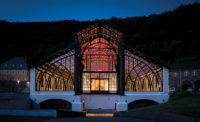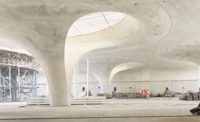Leipzig
The Wilhelm-Leuschner-Platz station lies 60 feet under the inner city of Leipzig, yet architect Max Dudler, who is based in Zürich, Frankfurt, and Berlin, wanted to create the impression that this public space is flooded with daylight. The station is one of four stops on the City Tunnel, a below-grade artery completed in 2013 that allows regional trains to pass under Leipzig, located 100 miles southwest of Berlin.
At its core, the Wilhelm-Leuschner-Platz station is a cavernous reinforced-concrete shell measuring 80 feet wide, 60 feet high, and 460 feet long, with ceiling girders spanning the width at 5-foot intervals. To create the illusion of a daylit space, the architect masked the structure and kept the architectural design simple. For their part, collaborating lighting designers Licht Kunst Licht “strove to minimize the visual impact of the lighting fixtures, and have the light appear to emanate from the architecture,” says lead designer Edwin Smida.
First the concrete shell and girders were painted white. Then the architect inserted a continuous semitransparent glass-block surface, held in place by a 10-by-10-foot grid of thin reinforced-concrete strips, leaving gaps of 5 feet from the walls and 6½ feet from the ceiling. The glass block is backlit by linear fixtures with T16 fluorescent lamps—chosen because their cool white color resembles daylight—placed along the rear of the concrete strips to direct light at the white-painted walls, girders, and ceiling. This results in indirect light that reflects off these surfaces and bounces out into the station through the glass blocks, which have a satin-finish on the back side and are transparent toward the platform. For commuters, it is like looking out onto a foggy day. “One does not feel claustrophobic,” notes Edwin Smida,“not only because of the unusual height, but also because we wanted to give the feeling of limitless space, like being outdoors.”
Three parallel rows of surface-mounted metal halide luminaires run the length of the ceiling. Unlike the wall fixtures, these are installed behind thin glass brick with 90 percent transmission, providing direct illumination to accent people and objects on the platform. These fixtures are also clustered above the ends of the platform, to illuminate the stairs and escalators leading to the street above. Two ceiling tracks, also placed along the length of the station, guide adjustable telescoping wagons to maintain and clean the glass blocks.
In keeping with the station’s minimalist aesthetic, three rectangular concrete boxes on the platform contain signage, advertising, and seating, and also house recessed, vandalism-proof luminaires with linear fluorescent lamps, which provide emergency lighting. At street level, wall-washing projectors equipped with asymmetrical wide-beam distribution and metal halide lamps illuminate the entrance pavilions, made of panels of transparent glass blocks and panes.
Descending from the city to the platform, the underground station initially appears dim when compared to daylight, even on an overcast day. Yet when one spends time there—as many commuters and travelers certainly do—one quickly adjusts to the reduced brightness, and the ruse that there is daylight takes over. Although the ceiling effect is less convincing, because the densely positioned girders impede an even reflection of light, the glass-block walls aid the illusion that this station is aboveground and that natural light shines through.
The station doesn’t feel like typical infrastructure. Ignore the arrival and departure signage, and one could mistake the gridded, glazed interior for a place of meditation: it’s surprisingly calming. If only for a few minutes while waiting for a train, the minimalist aesthetic and the impression of daylight offer a respite from urban stress and mitigate the reality of being deep below the city. “We wanted to restore a sense of dignity—and maybe even splendor—to this space of everyday life,” says project architect Christof Berkenhoff, “and create a place where people will like to be.”
PeopleClient: Deutsche Bahn AG, City of Leipzig, State Saxony, Federal Republic of Germany Owner: Leipziger Verkehrsbetriebe (LVB) GmbH
Architect:
Personnel in architect's firm who should receive special credit:
Structural Engineer:
Lighting Design:
Consultant: Acousticians & building physics: GRANER INGENIEURE GmbH, Leipzig General contractor: Ed. Züblin AG, Dresden Photographer(s): Christian Günther Size: 56,800 square feet Cost: approximately $20 million Completion Date: December 2013 |
ProductsStation Hall: Prefabricated reinforced concrete and glass block sections: Ed. Züblin AG
• The front of the elements was in fair-faced concrete quality (concrete grey); Entrances: Prefabricated reinforced concrete and glass blocks: Ed. Züblin AG
• The front of the elements was in fair-faced concrete quality (concrete grey); Prefabricated concrete elements between the concrete glass elements (facade & ceiling): Guido Teschner, Premnitz
• The front of the elements was in fair-faced concrete quality;
Flooring:
• The flooring on the platform was terrazzo (white); Stairs and flooring in the entrances: Dasag, Berlin
• The material for the steps, and the plating corresponded to the terrazzo on the platform (white);
Lighting Downlights: Norka surface mounted luminaire with a metal halide lamp (HIT lamp) for directional downlighting Task lighting/ security lighting at platform:Norka wall recessed (vandalism proof) luminaire with two linear fluorescent lamps Exterior entrance pavilion above ground:Bega surface-washer projectors with asymmetrical wide beam light distribution with a metal halide lamp |








Post a comment to this article
Report Abusive Comment